Tags
alfalfa, amaranth, bloodwort, catnip, cattail, chickweed, chicory, coltsfoot, crow garlic, Dandelion, Foraging, garlic mustard, ground ivy, hop clover, joe pye weed, ladys purse, lambs quarters, mallow, milkweed, miner's lettuce, mullein, nasturtium, pigweed, pineapple weed, plantain, purslane, self heal, silver weed, stringing nettle, sweet rocket, weeds, wild bee balm, Wild Edible Weeds, Wild Foods, wild grape vine, wild mustard, wild rose, wood sorrel, yellow rocket
Compiled by Yolanda Bertaud
Just a small list of wild edible weeds that we may encounter in our everyday environment without ever knowing the benefits and nutrition these wonderful plants provide. Please keep in mind to never second guess on what you forage, please further educate yourself on more details on each plant properties, identification, and edible parts, etc. Never harvest planets near roadsides, polluted waters/areas.
The Wild Green Garden aka Edible Weeds at my friends house and Guerrilla Seeding

Alfalfa (Lucerne) Medicago sativa
Edible parts: Leaves and young shoots can be eaten raw or cooked. The leaves can also be dried for tea good for stimulating your appetite or used in soups. Very nutritional food but must be used in moderation, can trigger attacks in patients with systemic lupus erythematosus. The seed are known to be used as a sprouted seeds which is added to salads, sandwiches, smoothies, raw food recipes, soups, or eaten as is. Alfalfa seeds can also be ground into a powder mixed with cereal flours for making nutritional breads and other baked goods.
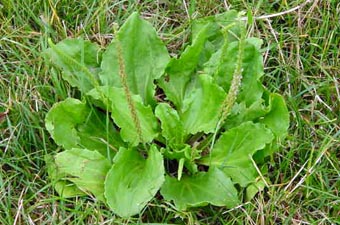 Broadleaf Plantain (Common Plantain) – Plantago major
Broadleaf Plantain (Common Plantain) – Plantago major
Edible parts: The entire plant. Young leaves can be eaten raw or cooked. They can be bitter and tedious to prepare if you desire to remove the fibrous strands before use, (though not required). By blanching the leaves in boiling water before edible use in salads makes them more tender. Once blanched, plantain can be frozen then used later in a sauté, soup or stew. Seeds can be eaten raw or cooked. The seed can be ground into a meal and mixed with flour. Dried leaves make a healthy herbal tea.
 Catnip (Catmint) Nepeta cataria
Catnip (Catmint) Nepeta cataria
Edible parts: Not only for cats! The young leaves can be eaten raw. Catnip has a mint-like flavor & adds an aromatic flavoring in salads. Older leaves can also be used as a spice flavoring in cooking.
Catnip leaves and flowers can be used fresh or dried to make a calming herbal tea. If making tea, it should be infused in a closed container in order to preserve the essential oils. Seeds and roots can also be used.
 Cattail (Bulrush) Typha latifolia
Cattail (Bulrush) Typha latifolia
Edible parts: The lower parts of the leaves can be used in a salad; the young tender stems can be eaten raw or boiled; the young flowers (cattails) can be roasted. Cattail pollen (appears mid-summer), the cattail pollen can be added to foods or smoothies for added nutrients. The whole pollen baring top of the cattail can be used instead of just shaking the pollen into a bag, just by stripping/breaking the pollen flowers top off the shoot (see instructional video below). Cattail pollen can be used as a thickener in soups and stews, smoothie, on top of yogurt, or mix it with flour for some great tasting bread. The root can be dried and pounded to make nutritious flour. Young shoots can be prepared like asparagus but requires longer cooking time to make them tender. You may add the young shoots towards the end of cooking a stew or soup to retain it’s refresh crunchiness. Makes a great stir-fry or excellent compliment to any dish!
cattail pollen
 Chickweed (Common Chickweed) Stellaria media
Chickweed (Common Chickweed) Stellaria media
Edible parts: Chickweed leaves can be eaten raw adding them to salads, juice recipes, or sandwiches. They can be tossed into soups and stews as well. You can also cook the stems and flowers mixing this with your favor meal.
Edible parts: Leaves, root and flower (the flower are edible but very bitter). Boil the leaves until well cooked, serve in bowl adding extra virgin olive oil with lemon, salt & pepper/gomasio. Save the liquid juice from the pot and drink as tea adding a little lemon. Dry the root for making delicious chicory root coffee!
Coltsfoot (Coughwort) Tussilago farfara
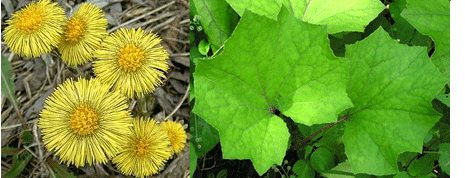
Edible parts: Flowers and young leaves can be eaten. Flowers can be eaten raw and mixed into a salad adding a wonderful aromatic flavor. Use the flower head and place them into a glass jar adding raw honey and storing it for a few weeks for its strength; this makes a great home remedy to help calm a cough, or just add some of this coltsfoot honey into your tea. You may dry the flower heads and use them as tea or in cooking/baking recipes. Young leaves are bitter but better after boiled them and then in salads, stews, or just add lemon & extra virgin olive oil & seasoning.
 Creeping Charlie (Ground Ivy) Glechoma hederacea
Creeping Charlie (Ground Ivy) Glechoma hederacea
Edible parts: Young leaves can be eaten raw or cooked. The leaves have a mild bitter flavor with a aromatic tang great for salads or jucing. You can cook these young leaves like spinach, or add to soups, stews, and omelet. Tea is made from the fresh or dried leaves. This wild edible has been known to be added to beer in much the same way as hops, for flavor and clarity.
Crow Garlic – Allium vineale

Edible Parts: Flowers, Leaves, Root. Leaves can be eaten raw or cooked. Rather stringy, they are used as garlic substitute. The leaves are available from late autumn until the following summer, when used sparingly they make a nice addition to the salad bowl. The bulbs are 10 – 20mm in diameter and are used as a flavoring, rather small, with a very strong flavor and odor. Bulbils can be eaten raw or cooked. Rather small and fiddly, they have a strong garlic-like flavor.

Dandelion (Lion’s Tooth) Taraxacum
Edible parts: Leaves, root, and flower. Flowers are sweetest when picked young. They have a sweet honey-like flavor. Mature flowers are bitter. Dandelion buds are tastier than the flowers. Dandelion leaves are bitter but great for raw juicing or boiling the leaves until tender – having it alone with 1/2 of fresh squeezed lemon and adding as much extra virgin olive oil as desire, salt & pepper or my favorite gomasio topping. Be sure to save the boiled dandelion water juice and drink this as a tea… this is mother nature’s medicine! The Greek’s call this “horta” (aka weeds) & is one of the favorite side dish/any other edible wild weeds are cooked and made the same way. Flowers can be made into juice, or added into many recipes. The root can be made into a coffee substitute. The root and leaves can be dried, stored and made into tea.
Stalking Wild Greens: Dandelion
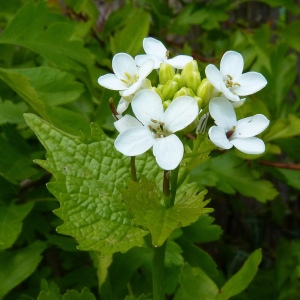
Garlic Mustard (Jack-by-the-Hedge) Alliaria petiolata
Edible parts: Flowers, leaves, roots and seeds. Leaves can be eaten in any season, when the weather gets hot, the leaves will have a taste bitter. Flowers can be chopped and tossed into salads. The roots can be collected in early spring and again in late fall, when no flower stalks are present. Garlic mustard roots taste very spicy somewhat like horseradish…. yummy! In the fall the seed can be collected and eaten.
Herb Robert (Bloodwort) Geranium robertianum
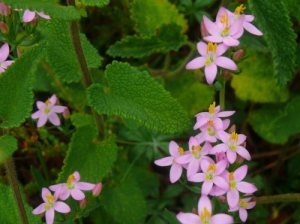
Edible parts: The entire plant. Fresh leaves can be used in salads or to make tea. The flower, leaves and root can be dried and stored using it later as a tea or herbs as a nutrient booster. Rubbing fresh leaves on the skin is known to repel mosquitoes, and the entire plant repels rabbits and deer which would compliment and protect your garden.
 Hop Clover (Low Hop Clover) Trifolium campestre
Hop Clover (Low Hop Clover) Trifolium campestre
Edible parts: The flowers, leaves and seeds are edible. All clover types are known to be part of the paleo diet of the First Nations people. Flowers can be put into teas. Seeds (in autumn) can be collected and eaten as is or roasted and can be ground into flour as well. Leaves can be tossed into salads, omelets, juicing, sandwiches, etc.
Joe Pye Weed (Gravel Root) Eupatorium purpureum
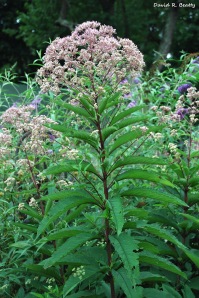
Edible parts: The entire plant can be used including the root. The leaves and stems can be harvested in the summer before the flower buds open and can be dried and stored for later use. The roots are harvested in the autumn. Fresh flowers can be used to make an herbal tea.
Joe Pye weed is named after a legendary Indian healer who used a decoction of the plant to cure typhus fever in colonial America. Native tribes used gravel root as a healing tonic included relieving constipation, washing wounds with a strong tea made from the root to prevent infection.
 Lambs Quarters Chenopodium album
Lambs Quarters Chenopodium album
Edible parts: The entire plant is edible – leaves, shoots, seeds, flowers. The seeds are potentially toxic containing saponins and should not be consumed in excess. Lamb’s quarters contain oxalic acid so when eating this raw, small quantities are recommended. Cooking removes this acid. Lamb’s quarter can be eaten in salads or added to smoothies and juices. Steaming this edible weed is one method of cooking, or can be added to soups, stews and more. You can dry this plant and add this nutritious plant to your meals. Blanch and freeze the leaves.
Mallow Malva neglecta 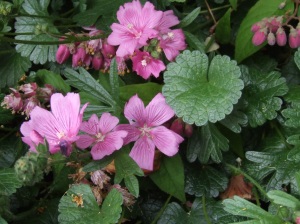
Edible parts:All parts of the mallow plant are edible — the leaves, the stems, the flowers, the seeds, and the roots (it’s from the roots that cousin Althaea gives the sap that was used for marshmallows). Because it’s a weed that grows plentifully in neglected areas, mallows have been used throughout history as a survival food during times of crop failure or war. Mallows are high in mucilage, a sticky substance that gives them a slightly slimy texture, similar to okra, great in soups. Mallow has a nice pleasant nutty flavor. One of the most popular uses of mallows is as a salad green. 
Miner’s Lettuce – Claytonia perfoliata
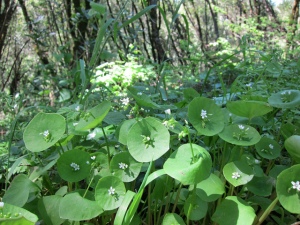
Edible Parts: Flowers, Leaves, Root. Leaves can be eaten raw or cooked. A fairly bland flavor with a mucilaginous texture, it is quite nice in a salad. The young leaves are best, older leaves can turn bitter especially in the summer and if the plant is growing in a hot dry position. Although individual leaves are fairly small, they are produced in abundance and are easily picked. Stalks and flowers can be eaten raw. A nice addition to the salad bowl. Bulb also can be eaten raw. Although very small and labor-intensive to harvest, the boiled and peeled root has the flavor of chestnuts. Another report says that the plant has a fibrous root system so this report seems to be erroneous.
Stalking Wild Greens: Miner’s Lettuce
 Milkweed (Silkweed) Asclepias syriaca
Milkweed (Silkweed) Asclepias syriaca
Edible parts: The young shoots, flower buds, flowers, young pods – is said to taste as good as asparagus and other cooked greens. These flower buds & pods are wonderful in stir-fry, soup, rice casseroles, and many other dishes, also can be fried in batter and eaten. Milkweed flower buds first appear in early summer and can be harvested for about seven weeks. It’s best to eat milkweed as a young shoot (under 15 cm).
Edible parts: Leaves and flowers. The flowers are fragrant and taste sweet, the leaves are not fragrant and taste slightly bitter. This plant is best known for a good cup of tea and can be consumed as a regular beverage. Containing vitamins B2, B5, B12, and D, choline, hesperidin, para amino benzoic acid, magnesium, and sulfur, but mullein tea is primarily valued as an effective treatment for coughs and lung disorders.
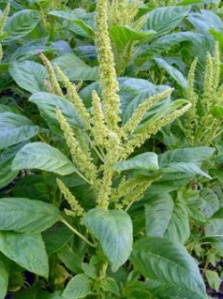
Pigweed Amaranth Amaranthus
Edible parts: The whole plant – leaves, roots, stem, seeds. The Amarath seed is small and very nutritious and easy to harvest, the seed grain is used to make flour for baking uses. Roasting the seeds can enhance the flavor, also you can sprout the raw seeds using them in salads, and in sandwiches, etc. Young leaves can be eaten raw or cooked like spinach, sautéed, etc. Fresh or dried pigweed leaves can be used to make tea.

Pineapple Weed (False Chamomile) Matricaria matricarioides
Edible parts: Pineapple weed flowers and leaves are a tasty finger food while hiking or toss in salads. Flowers can also be dried out and crushed so that it can be used as flour. As with chamomile, pineapple weed is very good as a tea. Native Americans used a leaf infusion (medicine prepared by steeping flower or leaves in a liquid without boiling) for stomach gas pains and as a laxative.
 Purslane (Portulaca) Portulaca oleracea
Purslane (Portulaca) Portulaca oleracea
Edible parts: The stems, leaves and flower buds are all edible. Purslane may be used fresh as a salad, stir-fried, or cooked as spinach is, and because of its mucilaginous quality it also is suitable for soups and stews. Australian Aborigines use the seeds to make seed cakes. Greeks, who call it andrakla (αντράκλα) or glystrida (γλυστρίδα), fry the leaves and the stems with feta cheese, tomato, onion, garlic,oregano, and olive oil, add it in salads, boil it or add to casseroled chicken. In Turkey, besides being used in salads and in baked pastries, it is cooked as a vegetable similar to spinach. In the south of Portugal (Alentejo), “baldroegas” are used as a soup ingredient. Because of its high water content Purslane cooks down quite a bit. Pick more than you think you will need. Makes a quick cold soup in hot weather by cooking and blending together with other vegetables.
 Self Heal (Heal All) Prunella vulgaris
Self Heal (Heal All) Prunella vulgaris
Edible parts: the young leaves and stems can be eaten raw in salads; the whole plant can be boiled and eaten as a potherb; and the aerial parts of the plant can be powdered and brewed in a cold infusion to make a tasty beverage. The plant contains vitamins A, C, and K, as well as flavonoids and rutin. Medicinally, the whole plant is poulticed onto wounds to promote healing. A mouthwash made from an infusion of the whole plant can be used to treat sore throats, thrush and gum infections. Internally, a tea can be used to treat diarrhea and internal bleeding.
Purchase Self-Heal (Prunella vulgaris) seeds, organic
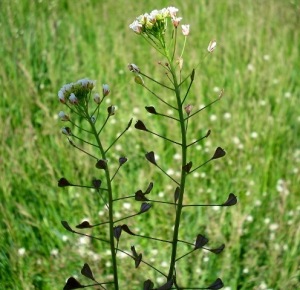 Shepherds Purse (Ladys Purse) Capsella bursa-pastoris (L.) Medic
Shepherds Purse (Ladys Purse) Capsella bursa-pastoris (L.) Medic
Edible parts: Flowers, leaves, roots, seeds and young shoots. Young leaves can be eaten raw or cooked and is a tasty addition to salads. The leaves are a cress and cabbage substitute that becomes peppery with age. The leaves are generally available all year round and can be dried for later use. Shepherd’s purse seeds are great on yogurt, salads, smoothies. The root is also edible; dried and ground up is can be used as a ginger substitute.
 Silverweed Potentilla anserina or Argentina anserina
Silverweed Potentilla anserina or Argentina anserina
Edible parts: All parts of the silverweed are edible, both leaves and root can be eaten raw or cooked. It can also be dried and ground into flour then used in soups etc or mixed with cereals. It has a nice taste, crisp and nutty with a somewhat starchy flavour. The wild roots are rather thin, though their size is improved in cultivation or semi-cultivation. Edible young shoots – raw can be eaten raw. A tea can be made from the leaves. The roots is best collected in autumn.
 Stinging Nettle (Nettle) Urtica dioica
Stinging Nettle (Nettle) Urtica dioica
EDIBLE PARTS: Young shoots. Only collect young shoots from areas you know have NOT been treated with pesticides. Collect the young shoots in the spring. Wear gloves while collecting shoots. PREPARATION: Soak young shoots in warm water to remove dirt and debris. Place young shoots in boiling, salted water (with a pair of kitchen tongs) and boil for five minutes. Makes an excellent spinach substitute and can be added as a vegetable to soups & stews. The stinging quality disappears after cooking. Nettles can be used in a variety of recipes, such as polenta, pesto and purée. Nettle soup is a common use of the plant, particularly in Northern and Eastern Europe. In Nepal and the Kumaon & Garhwal region of Northern India, stinging nettle is known as Sisnu, Kandeli and Bicchu-Booti (बिच्छू-बूटी in Hindi) respectively. It is also found in abundance in Kashmir. There it is called ‘Soi’. It is a very popular vegetable and cooked with Indian spices.
Warning: Stinging hairs on stems and leaves. Minor skin irritation when handled. Symptoms include intense burning and itching sensation lasting a few minutes.
 Sweet Rocket (Dame’s Rocket) Hesperis matronalis
Sweet Rocket (Dame’s Rocket) Hesperis matronalis
This plant is often mistaken for Phlox. Phlox has five petals, Dame’s Rocket has just four. The flowers, which resemble phlox, are deep lavender, and sometimes pink to white. The plant is part of the mustard family, which also includes radishes, broccoli, cabbage, cauliflower, and, mustard. The plant and flowers are edible, but fairly bitter. The flowers are attractive added to green salads. The young leaves can also be added to your salad greens (for culinary purposes, the leaves should be picked before the plant flowers). The seed can also be sprouted and added to salads. NOTE: It is not the same variety as the herb commonly called Rocket, which is used as a green in salads.
Watercress Nasturtium officinale L.
Edible parts: Leaves, seeds and the unripe nasturtium fruits can be pickled and used as a substitute for capers. Watercress Nasturtium are fast-growing, aquatic or semi-aquatic, perennial plants native to Europe and Asia, and one of

the oldest known leaf vegetables consumed by humans. They are members of the family Brassicaceae, botanically related to garden cress, mustard and radish — all noteworthy for a peppery, tangy flavor. Leaves can be eaten raw or cooked. Water cress is mainly used as a garnish or as an addition to salads, the flavor is strong with a characteristic hotness. It has a reputation as a spring tonic, and this is its main season of use, though it can be harvested for most of the year and can give 10 pickings annually. Some caution is advised if gathering the plant from the wild, any plants growing in water that drains from fields where animals, particularly sheep, graze should not be used raw. The leaves are exceptionally rich in vitamins and minerals, especially iron. The seed can be sprouted and eaten in salads. The seed can be ground into a powder and used as a mustard.
 Wild Bee Balm (Wild Bergamot) Monarda fistulosa
Wild Bee Balm (Wild Bergamot) Monarda fistulosa
Edible parts: Leaves boiled for tea, used for seasoning, chewed raw or dried; flowers edible. Wild bee balm tastes like oregano and mint. The taste of bee balm is reminiscent of citrus with soft mingling of lemon and orange. The red flowers have a minty flavor. Any place you use oregano, you can use bee balm blossoms. The leaves and flower petals can also be used in both fruit and regular salads. The leaves taste like the main ingredient in Earl Gray Tea and can be used as a substitute.
 Wild Grape Vine (Riverbank Grape) Vitis riparia
Wild Grape Vine (Riverbank Grape) Vitis riparia
Edible parts: Grapes and leaves. The ripe grape can be eaten but tastes better after the first frost. Juicing the grapes or making wine is most common. The leaves are also edible. A nutritional mediterranean dish called “dolmades”, made from grape leaves are stuffed with rice, meat and spices. The leaves can be blanched and frozen for use throughout the winter months.
Wild Mustard – sinapis arvensis
 Edible parts: Young leaves and seeds. Wild mustard grows all over the world, in Europe, Africa, Asia, the Americas, Australia, etc. Wild mustard is easy to identify and has no poisonous look a likes. It’s very versatile, flavorful, and uber-nutritious. Eating wild mustard on a regular basis will ensure that you never get sick. Wild mustard has cancer fighting agents, as well as being a good source of Vitamins A, C, D, and K, folate, potassium, calcium, iron, fiber, phosphorous, and even iron. A real power food!
Edible parts: Young leaves and seeds. Wild mustard grows all over the world, in Europe, Africa, Asia, the Americas, Australia, etc. Wild mustard is easy to identify and has no poisonous look a likes. It’s very versatile, flavorful, and uber-nutritious. Eating wild mustard on a regular basis will ensure that you never get sick. Wild mustard has cancer fighting agents, as well as being a good source of Vitamins A, C, D, and K, folate, potassium, calcium, iron, fiber, phosphorous, and even iron. A real power food!
Eat the flowering tops just before they open, they are cooked like broccoli. To cook, wash the greens well and cook in salted water. Wild mustard can be somewhat sharp when raw and somewhat bitter when cooked. Blanching it or boiling it in water for a few minutes will remove the bitterness (the longer you boil the less bitter it’ll be). It can be used like spinach in any recipe, or cook it the same way as dandelion leaves. The seeds are black and can be used to make mustard. They can also be used in pickling.
Wild Rose Taxonomy
 Wild roses are edible and medicinal. The fruit or hip can be eaten raw or cooked, remove the tiny hairs and seeds in the center. They are used in making jelly and jams and can also be dried to make a tea. Flower petals are great in salads adding a light flavor and beautiful color. The dried leaves are used as a tea substitute. Used as a medicinal plant all over the world for thousands of years wild roses are mentioned many old manuscripts and even in the tombs of Egyptian pharaohs. Wild roses are astringent, carminative, diuretic, laxative, nervine and tonic. An infusion of the leaves has been used as a spring tonic. An infusion of the hips and roots is used in the treatment of colds, fevers, influenza, minor infectious diseases, scurvey, diarrhoea, dysentery, and as a treatment for stomach complaints and gastritis. The dried flowers are used in the treatment of heartburn. The infusion has also been used as an analgesic to treat nervous headaches. Its pectoral qualities make it useful as a gargle for coughs and sore throat. A strong decoction of the whole plant is used to treat bladder infection, kidney problems, inflammations, stress, menstrual pains and nervousness. The main constituents responsible for these uses are citric acid, flavonoids, fructose, malic acid, sucrose, tannins, vitamins A, B3, C, D, E, and P, calcium, phosphorus, iron, rutine, hesperidin and zinc. Five wild rose hips are said to be much higher in vitamin C than a whole lemon. Wild roses are being investigated as a food that is capable of reducing the incidence of cancer and also as a means of halting or reversing the growth of cancers. Rose hips are also known to lower saturated fats and triglycerides, helping to control blood pressure and good for the heart. The seed is rich in vitamin E and an oil extracted from the seed is used externally in the treatment of burns, scars and wrinkles. A poultice of the chewed leaves is used in an emergency to allay the pain of bee stings.
Wild roses are edible and medicinal. The fruit or hip can be eaten raw or cooked, remove the tiny hairs and seeds in the center. They are used in making jelly and jams and can also be dried to make a tea. Flower petals are great in salads adding a light flavor and beautiful color. The dried leaves are used as a tea substitute. Used as a medicinal plant all over the world for thousands of years wild roses are mentioned many old manuscripts and even in the tombs of Egyptian pharaohs. Wild roses are astringent, carminative, diuretic, laxative, nervine and tonic. An infusion of the leaves has been used as a spring tonic. An infusion of the hips and roots is used in the treatment of colds, fevers, influenza, minor infectious diseases, scurvey, diarrhoea, dysentery, and as a treatment for stomach complaints and gastritis. The dried flowers are used in the treatment of heartburn. The infusion has also been used as an analgesic to treat nervous headaches. Its pectoral qualities make it useful as a gargle for coughs and sore throat. A strong decoction of the whole plant is used to treat bladder infection, kidney problems, inflammations, stress, menstrual pains and nervousness. The main constituents responsible for these uses are citric acid, flavonoids, fructose, malic acid, sucrose, tannins, vitamins A, B3, C, D, E, and P, calcium, phosphorus, iron, rutine, hesperidin and zinc. Five wild rose hips are said to be much higher in vitamin C than a whole lemon. Wild roses are being investigated as a food that is capable of reducing the incidence of cancer and also as a means of halting or reversing the growth of cancers. Rose hips are also known to lower saturated fats and triglycerides, helping to control blood pressure and good for the heart. The seed is rich in vitamin E and an oil extracted from the seed is used externally in the treatment of burns, scars and wrinkles. A poultice of the chewed leaves is used in an emergency to allay the pain of bee stings.
continue reading more plus video Rose Hips… a powerful antioxidant high in Vit. C
Wood Sorrel (Oxalis) Oxalis spp.
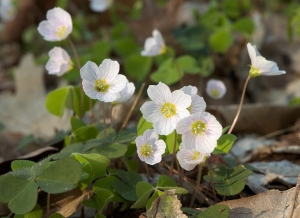
Ediable parts: Leaves, tubers, flowers & seed pods. Wood sorrel is an edible wild plant that has been consumed by humans around the world for millennia. In Dr. James Duke’s “Handbook of Edible Weeds,” he notes that the Kiowa Indian tribe chewed wood sorrel to alleviate thirst on long trips, that the Potawatomi Indians cooked it with sugar to make a dessert, the Algonquin Indians considered it an aphrodisiac, the Cherokee ate wood sorrel to alleviate mouth sores and a sore throat, and the Iroquois ate wood sorrel to help with cramps, fever and nausea. The edible tubers of the oca (O. tuberosa), somewhat similar to a small potato, have long been cultivated for food in Colombia and elsewhere in the northern Andes mountains of South America. The leaves of scurvy-grass sorrel (O. enneaphylla) were eaten by sailors travelling around Patagonia as a source of vitamin C to avoid scurvy. In India, creeping wood sorrel (O. corniculata) is eaten only seasonally, starting December/January. The leaves of common wood sorrel (O. acetosella) may be used to make a lemony-tasting tea when dried.
Yellow Rocket (Wintercress) Barbarea vulgaris

It tends to grow in damp places such as hedges, stream banks and waysides and comes into flower from May to August. Yellow Rocket was cultivated in England as an early salad vegetable. It makes a wonderful salad green when young and the greens are also an excellent vegetable if treated kindly. Lightly steam or gently sweat in butter until just wilted. The unopened inflorescences can also be picked and steamed like broccoli.
Reference source:
Great ethnobotany/foraging websites:
Related Links: Health & Wellness



Reblogged this on philerupp's Blog.
GREAT article,thank you
Very good information! Thank You! 😉
Passed this on to Cinebar Self Sufficient Group!
Beneficial weeds in a young food forest – polyculture! ~ http://www.youtube.com/watch?v=ESyCbN7Psps&feature=youtube_gdata_player
Best L I’ve come across thank you!
Your welcome ♡
Reblogged this on The Bipolar Homestead and commented:
Super informative with pics that are useful
Reblogged this on Dogwood Hollow Homestead-Off Grid and commented:
Part of living off the grid and getting back to a more natural way of life is learning to walk into nature and see every plant, useful, as a medicine or a food…At Dogwood Homestead, we mean to do just that daily…and we do 🙂
Super post! I reblogged this to Dogwood Hollow Homestead blog and shared it across my network of off gridders and homesteaders!